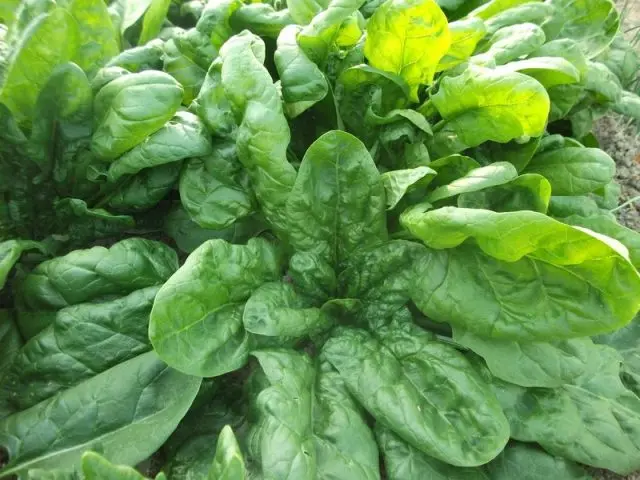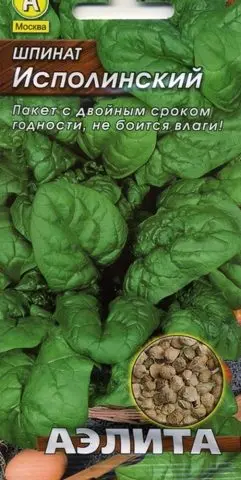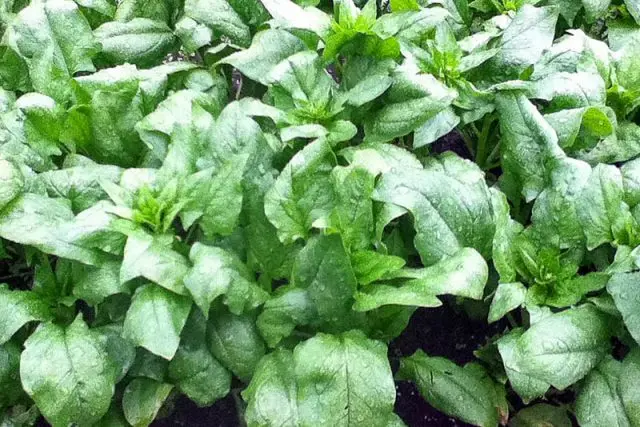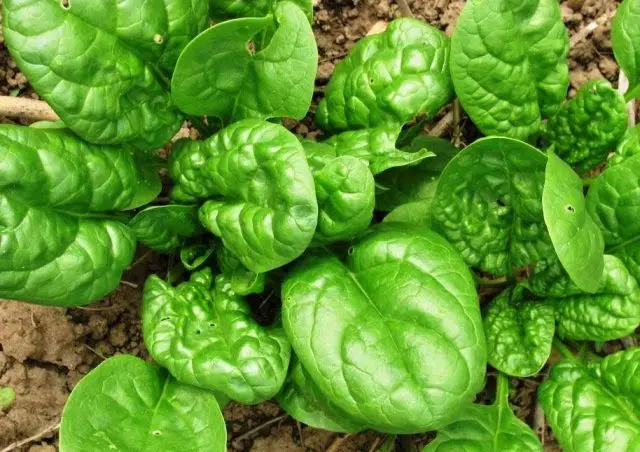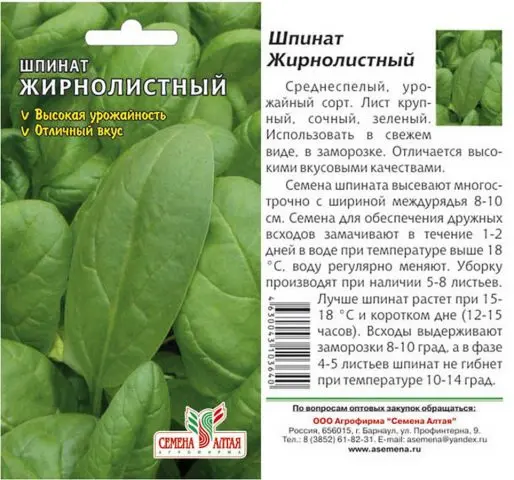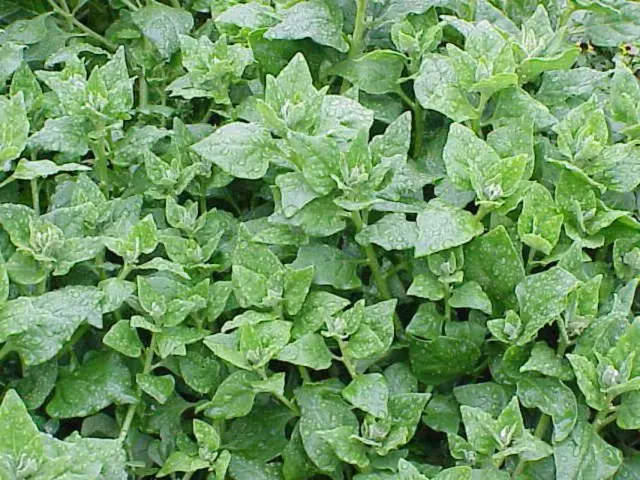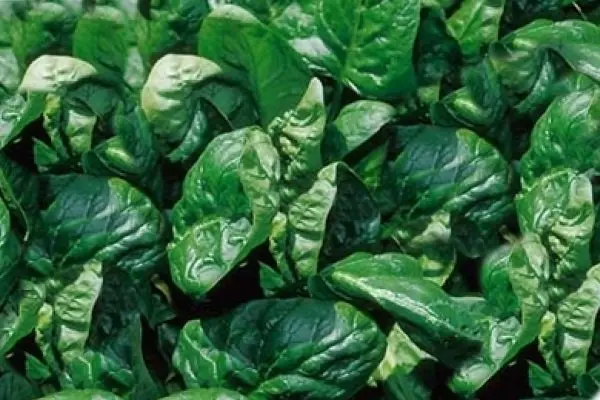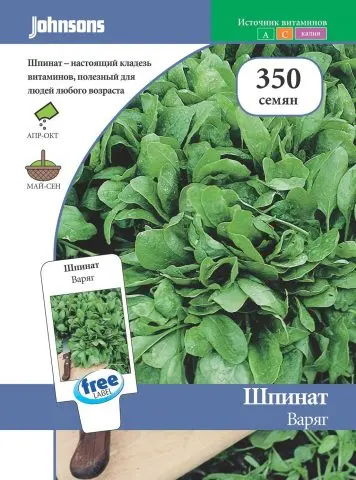Contents
Spinach is a popular green salad vegetable that can also be cooked. It is not difficult to grow a vitamin culture, but there are certain subtleties in caring for a plant that affect the quality of the product. Eat the top young leaves of spinach.

Description of garden spinach
A herbaceous garden plant with an annual development cycle belongs to the Amaranth family. The root system of spinach consists of a tap root, 10-20 cm long, and small shoots. A rosette of 7-13 dark or light green oval leaves forms above the surface. The shape of the leaf blade can also be spear-shaped. The height of a young edible plant is 18-25 cm. Fleshy leaf blades are smooth or wrinkled, slightly rough, differ in shape and color intensity in different varieties. The upper part of the leaf is glossy, with clearly visible veins. The leaves are attached to the base with strong petioles, sometimes burgundy-red.
Spinach is dioecious; there are male and female plants. From the middle of summer, a peduncle with small yellow buds grows from the outlet. In male plants it is in the form of a tall panicle, in female plants it is in the form of a panicle with leaves. Flowers are produced in the axils of the leaves. Then small fruits, nuts ripen. Seeds can be used for sowing next year if one variety grows in the garden.
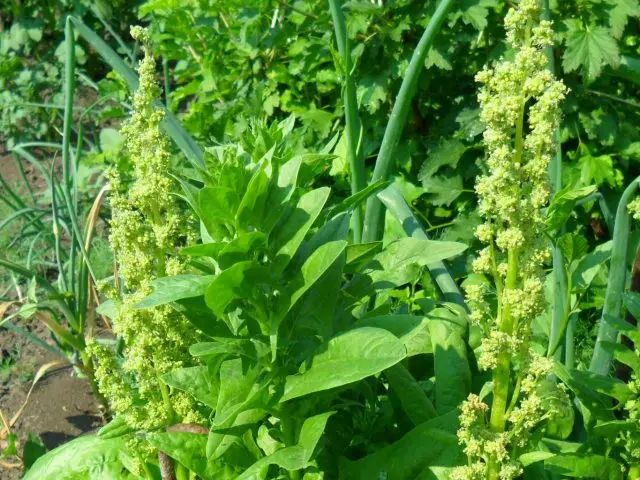
Varieties of garden spinach
The culture has been grown for a long time in many countries, there are various varieties that are divided according to the ripening period:
- early ripe;
- average;
- later.
For conditions, many varieties of garden spinach are also recommended. Among the early popular:
- Virofle – with large leaves, which is sown very early, because it shoots quickly;

- Gigantic – a variety whose leaves are cut 16-20 days after germination;

- Stoic, suitable for growing in temperate climates, cold-resistant, the most productive – up to 2-3 kg per 1 sq.m.

In the group of early garden greens, other varieties are known – Godri, Marquise, Strawberry, as well as spinach sorrel, which is also called Uteusha spinach.
The leaves of mid-season garden spinach are cut after 1-1,5 months:
- matador, Czech variety, attractive because it does not form arrows;

- oily – domestic selection, high-yielding, ripens in 35-45 days;

- Mighty – resistant to spring frosts and shooting, culture for regions with a harsh climate.

In addition to these varieties, Mariska, Bloomsdelsky, Victoria are common in the spinach group of the average harvesting period. This also includes other garden plants commonly called spinach, which belong to different families:
- new zealand spinach, up to 80-100 cm high, which in botany is defined as tetragony;

- Indian, known as Basella as an indoor climbing plant.

Juicy and crispy leaves of late varieties of garden green vegetables grow for 2 months:
- spokane f1, Dutch selection, high-yielding, hardy, light-loving species, which has a low susceptibility to fungal diseases;

- Current f1 – a moisture-loving variety intended for open garden soil, pleases with a large rosette of fleshy leaves;

- Varangian, which is distributed by the American company Johnsons, which produces seeds, is distinguished by the presence of a pleasant sourness in the taste.

Useful properties of garden spinach
Widespread varieties of spinach do not have any pronounced taste, but are valued for their beneficial effects on the body:
- tonic;
- anti-inflammatory;
- antioxidant;
- diuretic;
- mild laxative.
It is believed that the regular use of spinach strengthens the cardiovascular system, has a positive effect on vision and the organs of the musculoskeletal system. It is recommended to use an early spring garden plant as a dietary component that contains few calories, and a tonic for residents of areas with high radiation.
Planting and caring for garden spinach
The cultivation of this garden greenery has its own specifics, which should be taken into account for the fruitful collection of leaves. In the south, green crops are sown in open ground before winter and early in April or even March. In the areas of the middle lane, they are grown under a film in spring and also sown in autumn. Many varieties are cold-resistant, seeds germinate at temperatures above + 3 оC. Lettuce grows well in greenhouses, where it is used as a compactor in areas with tomatoes, eggplant, sweet peppers.
Site preparation
The soil for spinach should be nutritious and constantly moist, because the roots of the plant are short, located close to the surface. For sowing seeds of garden early spring greens, areas are excluded:
- dry;
- with sandy soil;
- sour;
- located in a draft.
The beds are broken up in a sunny place, protected from the north wind. Culture puts up with a slight penumbra that falls on the site at lunchtime. In the garden, fertilized with organic matter in the fall, add 1 sq. m the following mineral preparations:
- 10-15 g of urea;
- 15 g of potassium sulfate;
- 30 g superphosphate.
30-50 g of complex preparations with an approximate percentage are also used.
Seed preparation
Untreated seeds are soaked in water at room temperature for 20-30 hours. If desired, then you can treat with growth stimulants according to the instructions. The seeds are dried before sowing.
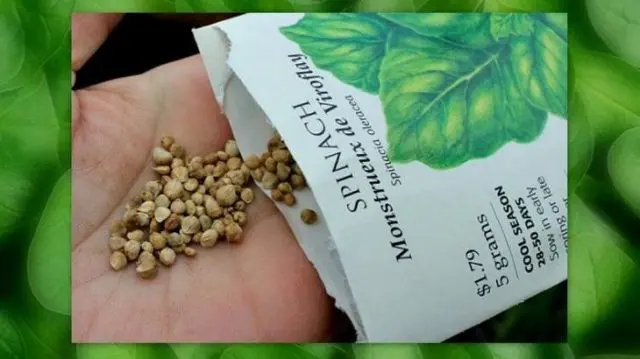
Rules of landing
Spinach is sown in rows with a distance of 30 cm or ribbons in which 2-3 lines are placed. An interval of 20 cm is observed between the lines, and up to 50 cm between wide stripes. The sowing depth is different according to the types of soil:
- in dense – 2,5 cm;
- on loams and sandy loams – 4 cm.
After sowing, the soil is lightly compacted. The first shoots appear after 6-8 days.
Watering and top dressing
Spinach is a moisture-loving garden crop. The leaves are elastic and fleshy, if the bed is sufficiently moistened. Otherwise, the plant begins to quickly shoot. Particularly take care of timely watering in the south. If it rains and the weather is cool, watering is not needed, because fungal diseases develop with excess moisture. After the appearance of 2-3 leaves, garden greens are fed with organic solutions and wood ash. Fertilizer is repeated after 9-12 days.
Weeding and loosening
At the first weeding, the crops are thinned to an interval between plants of 10 cm. Loosening retains moisture in the soil, removes weeds. The hoe is deepened by 6-7 cm, trying not to damage the spinach roots. Apply and mulching between rows.
Diseases and pests
In thickened plantings that have not been thinned out, fungal and viral diseases can develop in cool weather, constant rain or excessive watering:
- Fusarium root rot, especially common in the northwestern regions;
- downy mildew;
- various spots;
- mosaics and curliness, which significantly reduce the yield.
Affected bushes are removed. If a disease is detected on the site, the same crop is sown only after 3-4 years.
Many green pests – mining flies, caterpillars, aphids – are first bred on garden weeds. Especially on different types of quinoa, plants of the Amaranth family, to which spinach, beets, and chard belong. Therefore, a bed with crops of early spring garden crops is carefully weeded. They get rid of a large number of insects by using infusions of tobacco, tomato stalks, as well as Phytoferm, Bitoxibacillin.
Harvesting
Spinach leaves are ready for harvest when there are more than 5 of them in the outlet. It is better to harvest in the morning, breaking off one leaf at a time or cutting off the entire outlet. They also practice pulling out a bush with roots, especially with a dense planting. In the refrigerator, unwashed leaves wrapped in a bag are stored for 3 days. Valuable garden greens are also frozen, dried or ground with salt, stored in jars. After the appearance of the peduncle, the collection of spinach is stopped.
Reproduction
Depending on the variety, the leaves are harvested on the 25th-60th day of plant development. Then flower stalks are created. Seeds ripen in 3-3,5 months. Sowing in the south is sometimes carried out in August, covering the emerging plants for the winter. Early varieties of spinach are sown in the spring in the garden and in the greenhouse.
Conclusion
Garden spinach is often scattered dotted around the garden, compacting plantings of lettuce, celery, and kohlrabi. Growing greens, we must remember that the leaves are useful only before the formation of peduncles. In a greenhouse, a plant can quickly shoot itself at high temperatures.










